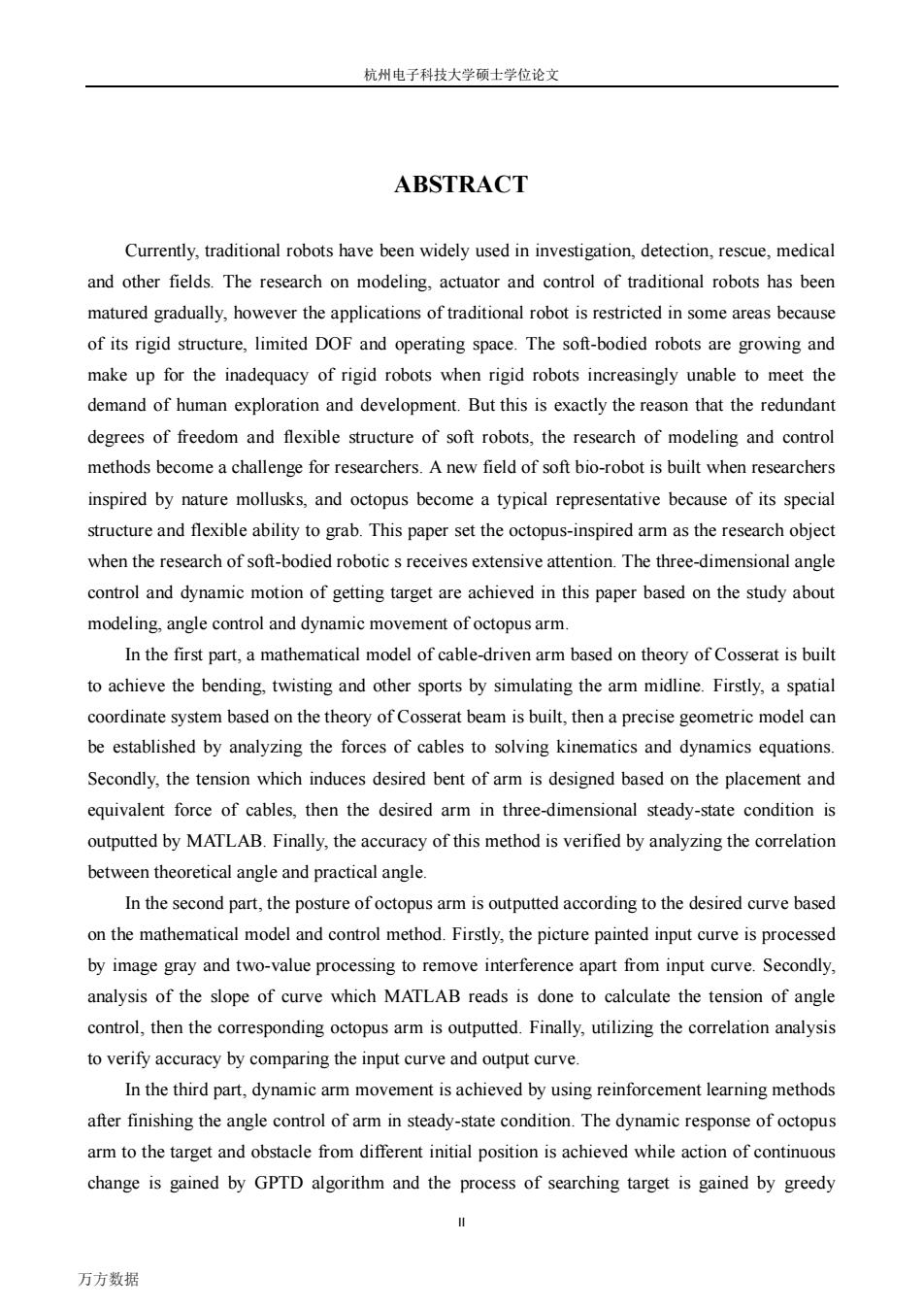正在加载图片...

杭州电子科技大学硕士学位论文 ABSTRACT Currently,traditional robots have been widely used in investigation,detection,rescue,medical and other fields.The research on modeling,actuator and control of traditional robots has been matured gradually,however the applications of traditional robot is restricted in some areas because of its rigid structure,limited DOF and operating space.The soft-bodied robots are growing and make up for the inadequacy of rigid robots when rigid robots increasingly unable to meet the demand of human exploration and development.But this is exactly the reason that the redundant degrees of freedom and flexible structure of soft robots,the research of modeling and control methods become a challenge for researchers.A new field of soft bio-robot is built when researchers inspired by nature mollusks,and octopus become a typical representative because of its special structure and flexible ability to grab.This paper set the octopus-inspired arm as the research object when the research of soft-bodied robotic s receives extensive attention.The three-dimensional angle control and dynamic motion of getting target are achieved in this paper based on the study about modeling,angle control and dynamic movement of octopus arm. In the first part,a mathematical model of cable-driven arm based on theory of Cosserat is built to achieve the bending,twisting and other sports by simulating the arm midline.Firstly,a spatial coordinate system based on the theory of Cosserat beam is built,then a precise geometric model can be established by analyzing the forces of cables to solving kinematics and dynamics equations. Secondly,the tension which induces desired bent of arm is designed based on the placement and equivalent force of cables,then the desired arm in three-dimensional steady-state condition is outputted by MATLAB.Finally,the accuracy of this method is verified by analyzing the correlation between theoretical angle and practical angle. In the second part,the posture of octopus arm is outputted according to the desired curve based on the mathematical model and control method.Firstly,the picture painted input curve is processed by image gray and two-value processing to remove interference apart from input curve.Secondly, analysis of the slope of curve which MATLAB reads is done to calculate the tension of angle control,then the corresponding octopus arm is outputted.Finally,utilizing the correlation analysis to verify accuracy by comparing the input curve and output curve. In the third part,dynamic arm movement is achieved by using reinforcement learning methods after finishing the angle control of arm in steady-state condition.The dynamic response of octopus arm to the target and obstacle from different initial position is achieved while action of continuous change is gained by GPTD algorithm and the process of searching target is gained by greedy 万方数据杭州电子科技大学硕士学位论文 II ABSTRACT Currently, traditional robots have been widely used in investigation, detection, rescue, medical and other fields. The research on modeling, actuator and control of traditional robots has been matured gradually, however the applications of traditional robot is restricted in some areas because of its rigid structure, limited DOF and operating space. The soft-bodied robots are growing and make up for the inadequacy of rigid robots when rigid robots increasingly unable to meet the demand of human exploration and development. But this is exactly the reason that the redundant degrees of freedom and flexible structure of soft robots, the research of modeling and control methods become a challenge for researchers. A new field of soft bio-robot is built when researchers inspired by nature mollusks, and octopus become a typical representative because of its special structure and flexible ability to grab. This paper set the octopus-inspired arm as the research object when the research of soft-bodied robotic s receives extensive attention. The three-dimensional angle control and dynamic motion of getting target are achieved in this paper based on the study about modeling, angle control and dynamic movement of octopus arm. In the first part, a mathematical model of cable-driven arm based on theory of Cosserat is built to achieve the bending, twisting and other sports by simulating the arm midline. Firstly, a spatial coordinate system based on the theory of Cosserat beam is built, then a precise geometric model can be established by analyzing the forces of cables to solving kinematics and dynamics equations. Secondly, the tension which induces desired bent of arm is designed based on the placement and equivalent force of cables, then the desired arm in three-dimensional steady-state condition is outputted by MATLAB. Finally, the accuracy of this method is verified by analyzing the correlation between theoretical angle and practical angle. In the second part, the posture of octopus arm is outputted according to the desired curve based on the mathematical model and control method. Firstly, the picture painted input curve is processed by image gray and two-value processing to remove interference apart from input curve. Secondly, analysis of the slope of curve which MATLAB reads is done to calculate the tension of angle control, then the corresponding octopus arm is outputted. Finally, utilizing the correlation analysis to verify accuracy by comparing the input curve and output curve. In the third part, dynamic arm movement is achieved by using reinforcement learning methods after finishing the angle control of arm in steady-state condition. The dynamic response of octopus arm to the target and obstacle from different initial position is achieved while action of continuous change is gained by GPTD algorithm and the process of searching target is gained by greedy 万方数据